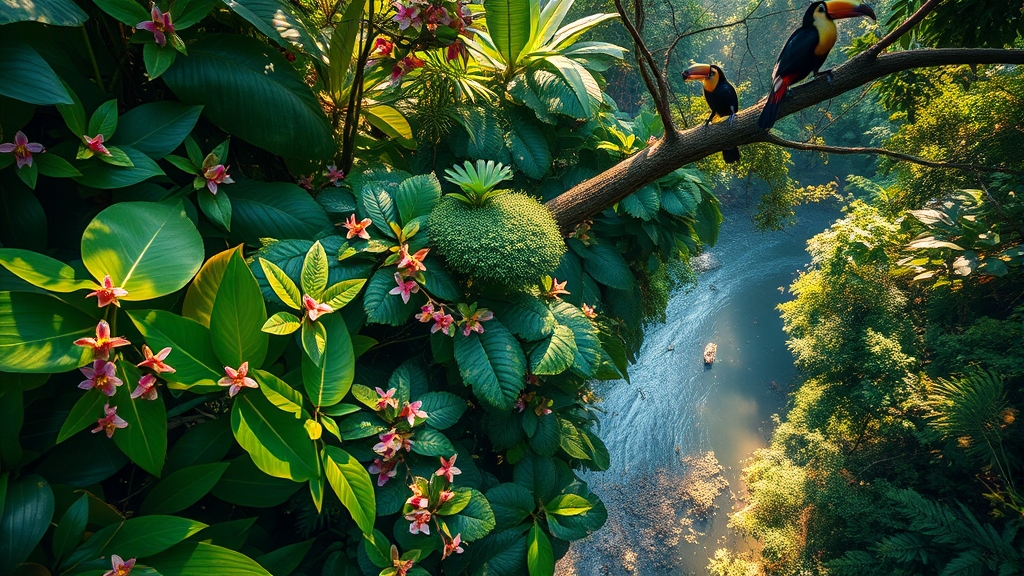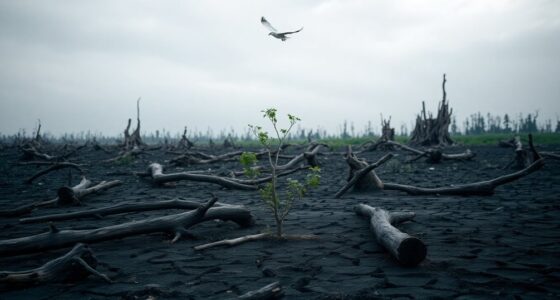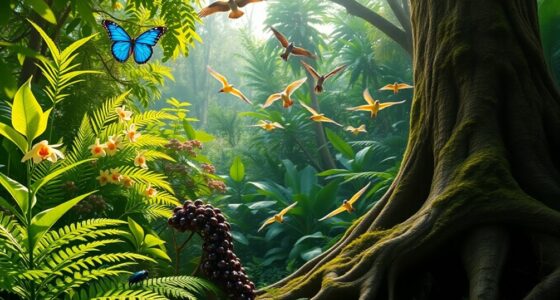Earth boasts an estimated 8.7 million eukaryotic species, but we’ve only identified a small portion so far. This highlights the vast unknown biodiversity that still exists on our planet. Tropical rainforests are among the most biologically diverse ecosystems, supporting countless species. Human activities threaten this rich variety through deforestation, pollution, and climate change, causing many species to vanish. If you stay curious, you’ll discover more fascinating facts about Earth’s incredible biological diversity.
Key Takeaways
- Approximately 8.7 million eukaryotic species are estimated to exist on Earth, with only a fraction formally described.
- Tropical rainforests host the highest levels of biodiversity, containing over half of the world’s species.
- Human activities threaten 1 million species with extinction due to deforestation, pollution, and climate change.
- Species richness varies greatly across ecosystems, with some areas like coral reefs supporting thousands of species.
- Protecting habitats and restoring ecosystems are essential strategies to preserve global biodiversity.

Have you ever wondered why biodiversity matters? It’s because our planet teems with a staggering variety of life, from tiny insects to massive whales. This diversity, known as biodiversity, is essential for maintaining healthy ecosystems and supporting life as we know it. One way to understand this richness is through the concept of species richness, which measures the number of different species present in a particular area. The more species an ecosystem hosts, the higher its species richness. For example, tropical rainforests boast thousands of plant, animal, and insect species, making them some of the most biologically diverse places on Earth. But despite this incredible variety, many species are at risk, and the world faces significant conservation challenges.
You might not realize it, but human activities are the primary drivers of these challenges. Deforestation, pollution, climate change, and overexploitation threaten countless species daily. As habitats shrink and resources become scarcer, species richness declines, leading to less resilient ecosystems. This loss isn’t just about missing out on beautiful animals or plants; it impacts the entire web of life, including humans. When species disappear, ecological functions like pollination, water purification, and carbon storage are compromised, which can lead to severe environmental and economic consequences. Addressing these conservation challenges requires immediate action, but it’s also about understanding the scale of the problem. Globally, scientists estimate that millions of species remain undiscovered, and many of these are already teetering on the brink of extinction. Recognizing the extent of undiscovered biodiversity can help prioritize research and conservation efforts effectively.
You may wonder how many species are actually out there. Current estimates suggest there are around 8.7 million eukaryotic species, but only a fraction has been formally described. This means the true extent of Earth’s biodiversity remains largely unknown. This vast unknown biodiversity highlights the importance of conservation efforts to protect both documented and undiscovered species. Protecting existing habitats and restoring degraded ones are essential steps toward preserving species richness. Furthermore, fostering awareness about the importance of biodiversity can inspire more people to get involved in conservation initiatives. Every species lost diminishes the planet’s natural heritage and reduces its resilience to environmental changes. Additionally, advances in biodiversity research continue to reveal new insights into how species interact within ecosystems, emphasizing the importance of comprehensive conservation strategies. Recognizing that biodiversity is interconnected and fragile underscores the need for holistic approaches to preservation and the importance of ecosystem stability in maintaining planetary health. By recognizing the value of biodiversity and tackling the conservation challenges head-on, you can help guarantee that future generations inherit a planet teeming with life, diversity, and vitality.
Frequently Asked Questions
How Does Biodiversity Impact Human Health?
Biodiversity directly impacts your health through ecosystem services like clean air, water, and food production. You rely on the genetic diversity within species to develop medicines and improve crops. When biodiversity declines, these essential services weaken, increasing health risks. Protecting biodiversity guarantees these benefits continue, safeguarding your well-being and resilience against diseases. Your actions to preserve ecosystems and genetic variety support a healthier planet and your own health.
What Are the Main Threats to Global Biodiversity?
You should know that habitat loss and invasive species are the main threats to global biodiversity. Habitat loss from deforestation, urbanization, and agriculture reduces living spaces for many species. Invasive species, introduced accidentally or intentionally, outcompete native plants and animals, disrupting ecosystems. These threats weaken biodiversity, making ecosystems less resilient and affecting the services they provide, which ultimately impacts human well-being. Addressing these issues is essential to protect our planet’s health.
How Are Extinct Species Documented and Studied?
Imagine piecing together a lost melody—that’s how you document extinct species. You explore the fossil record, which acts as a time capsule revealing ancient life. Studying the extinction timeline helps you understand when and how species vanished. Through careful examination of bones, footprints, and preserved remains, you reconstruct their stories, ensuring these silent voices are heard and remembered in the grand symphony of Earth’s history.
Which Regions Are Most Biodiverse on Earth?
You’ll find the most biodiverse regions in tropical rainforests and coral reefs. These areas teem with countless species because of their warm climates and abundant resources. Tropical rainforests, like the Amazon, support a vast array of plants and animals, while coral reefs, such as the Great Barrier Reef, host diverse marine life. Exploring these regions reveals the incredible variety of life that makes Earth so vibrant and resilient.
What Efforts Are in Place to Protect Endangered Species?
You can help protect endangered species through various efforts. Habitat restoration plays a vital role by repairing damaged ecosystems, providing safe spaces for wildlife. Wildlife corridors connect fragmented habitats, allowing animals to migrate and find resources safely. Supporting conservation programs and advocating for policies that prioritize biodiversity also make a difference. By understanding these strategies, you contribute to safeguarding endangered species and ensuring healthier ecosystems for future generations.
Conclusion
You might think Earth’s biodiversity is limitless, but studies show it’s actually declining due to human activity. Some experts believe that if current trends continue, we could lose up to 70% of species by 2100. This highlights the urgent need to safeguard ecosystems now. By understanding these numbers and acting, you can help ensure future generations experience the richness of life on our planet. Every small step counts in preserving Earth’s incredible diversity.









